#Shōjo Comic
Explore tagged Tumblr posts
Photo
Cover to issue #1 of Mayumi Yoshida's Idol wo Sagase ("Look for Your Idol"), published by Kodansha's mimi shōjo manga line.

#1980s#manga#idol wo sagase#look for your idol#mayumi yoshida#shojo#shōjo#comic#comic cover#comic covers#illustration#japan#mimi#kodansha#kodansya#comics#comic book#comic books
2K notes
·
View notes
Text

I haven’t drawn anything this month, so here’s one of my forever WIPs (Oh man, I have sooo many forever WIPs😅): Louis in an old shōjo manga style from my unfinished fan comic of VC
64 notes
·
View notes
Text
Since August begins, I would like to present a series of events that come together to do something very funny:
• After several attempts since 1966, The Clown Club of America managed to get Richard Nixon to proclaim in 1971 the start of International Clown Week on August 1st.
• DC comics declared in 1976 that August 1st would be The Joker's birthday (probably greatly influenced by past event). Also in various comics the number "0801" is given to Joker's cell and I'll let Batman explain how curious this is:



• A subgenre of shōjo manga focusing on romantic or sexual relationships between male characters, emerged in the late 1970s called YAOI (yama nashi, ochi nashi, imi nashi. No climax, no point, and no meaning). Which became so popular that consumers of this genre in Japan set yaoi day on August 1st (801):
8 'ya' (や) from the first syllable of the number "8" when it is pronounced 'yattsu' (八つ).
0 due to its similarity to the Roman letter "O".
1 'i' (い) from the first syllable of the number "1" pronounced 'ichi' (いち).
• Finally, it must be mentioned that the homoerotic subtext between Batman and Joker has been so constant that it becomes part of the context during their more than eighty years of feuding life.
Also, how is it that the Joker is one, if not the best example of obsession and twisted love, as well as an icon of villains as queer representation.

So many coincidences over the years and so many different events bring us to this moment in which I can say moved and amused, implying each of the points before:
Happy 801 day Clown Prince of Crime!
#the joker#joker#batman#I know I'm late by a day but still clown week is still going on 🥳🎉#I wrote this really emotional and not because of what was said but bc of what was implied#For more than a decade I have loved that silly clown and maybe i will continue to#i want to witness his 100 years of history 🥹💕
28 notes
·
View notes
Text
I've been going through my collection of old (pre-2016 for the most part) academic papers on BL and thought, hey, why not re-read some of them and sum them up so folks can see whether they want to check them out in full?
Today's offering:
Beautiful, Borrowed, and Bent: “Boys’ Love” as Girls’ Love in Shōjo Manga by James Welker, originally presented at the Third International Convention of Asia Scholars, August 19–22, 2003, Singapore, and published in Signs, Vol. 31, No. 3, New Feminist Theories of Visual Culture (Spring 2006), pp. 841-870, UChicago Press. [Jstor]
Welker starts off with a brief explanation of what the BL genre is, what terminology he uses ("BL" as an umbrella term that includes the earlier names of tanbi, shōnen ai, yaoi, and the long-form 'boys' love'):
“Boys’ love” manga emerged as a subgenre of shōjo manga (girls’ comics) around 1970 just as women artists were taking over the shōjo market.(*) It quickly became among the most popular shōjo manga genres, and its creators became some of the best-loved artists in the industry. (* First published in the monthly Bessatsu shōjo komikku in December 1970, Keiko Takemiya’s “In the Sunroom” (Sanrūmu nite [1970] 1976) was probably the first boys’ love narrative. See Aoyama 1988, 188.) - Welker 2006:841
He goes on to challenge the common perception of BL as a genre "by straight women for straight women":
[T]he genre is widely considered to offer a liberatory sphere within which presumably heteronormative readers can experiment with romance and sexuality through identification with the beautiful boy characters. […] Members of the Japanese lesbian community have, however, pointed to boys’ love and other gender-bending manga as strong influences on them in their formative years […] Clearly boys’ love manga can be viewed through a different lens from that which most critics and scholars have been using, and hence the full potential of boys’ love is largely overlooked: that of liberating readers not just from patriarchy but from gender dualism and heteronormativity. - Welker 2006:842-843
He introduces the texts he will analyse (Takemiya Keiko's Song of Wind and Trees 風と木の詩 kaze to ki no uta, 1976-1984 and Hagio Motō's Heart of Thomas トーマの心臓 tōma no shinzō, 1974), and concludes the essay's intro section as follows:
This reading will employ lesbian critical theory, visual theory, and reader responses to these and similar texts to show how 1970s boys’ love manga is not merely queer on its surface but how it opened up space for some readers to experiment with marginalized gender and sexual practices and played a role in identity formation. - Welker 2006:843
Welker goes into the questions of applicability of theories that weren't originally developed for this specific context – visual theories were largely developed through film analysis; European and North American models of gender and feminist theory, while also having informed academic discourse in Japan, in their origin operate on culturally specific assumptions and need to be applied with care.
He talks about the tradition of androgynous and cross-dressing heroines of early shōjo manga and their connection to the earliest BL manga, the dilemma of the "beautiful boy" characters' gender and sex and how to read these – are they boys? idealised self-images of girls drawn onto boys' bodies? neither male nor female? sexless altogether?, and the way Japanese readers in the 1970s, already culturally familiar with gender performance through kabuki or the all-female Takarazuka Revue and similar troupes, received the gender-bending nature of BL stories. He also comments on the role fan interaction via magazines, and the way readers were learning about queer life in Japan:
By the early to mid-1980s, the magazines’ readers were learning in real terms about the world of Shinjuku ni-chōme, Tokyo’s well-known gay district, described as a world full of “beautiful boys like those in the world of shōjo manga” (Aran 1983, 15), as well as various aspects of lesbian life in Japan (Gekkō 1985). In spite of the connections drawn on the pages of these magazines, the possibility that these narratives might be seen to actually depict homosexuality remains broadly denied. To allow that the narratives might truly be about homosexuality—between these girls-cum-beautiful boys—would be an apparently unthinkable invitation to read the narratives as lesbian. - Welker 2006:857
Welker briefly explores how the example texts of Song of Wind and Trees and Heart of Thomas "serve many of the functions lesbian critics and theorists have outlined as roles of lesbian texts" (Welker 2006:858), then goes on to analyse the flower imagery of roses and lilies that is very prevalent in both titles, the intertextuality of these stories with European and French literature (and how the readers were expected to catch on to this intertextuality). On the transgressive and queering nature of writing and reading BL, he says:
[T]hrough acculturation to gender performance in Takarazuka and kabuki and by such cross-dressing manga icons as Sapphire and Oscar, as well as the deliberate ambiguity of the beautiful boy, the reader is encouraged to see not just a girl but herself within the world of boys’ love and, ultimately, is encouraged to explore homoerotic desire, either as a beautiful boy or as herself, either alone or with others, either as her fantasy or as her reality. […] Regardless of whether boys’ love manga were created merely to offer heterosexual readers a temporary respite from patriarchal restrictions on their desire, some readers found in identifying with the beautiful boy a way through the looking glass to a world outside the patriarchy. And regardless of whether he is read as a boy or a girl, the beautiful boy can be read as a lesbian. […] For readers whose experience of sexuality and gender contravenes heteronormativity, works like Song and Thomas offer narrative safe havens where they can experiment with identity, find affirmation, and develop the strength necessary to find others like themselves and a sense of belonging. - Welker 2006:865-866
I've been out of academia so long that I've lost any sense of what a good proportion of direct quotes to original text is, or whether it's even appropriate to quote as much as I did here. This is emphatically NOT an academic article in and of itself -- I'm posting on bloody tumblr. If anyone wants to add to this, I'll be thrilled.
One of the most commonly voiced criticisms of BL is that it's about, but not (or did not in significant part used to be) by or for gay men. This article does not address this point further—Welker does go into this in his more recent articles, iirc; if you've got beef with this aspect, @ him not me. I do however think it's worth noting that this 17-year-old article already recognises that the genre is queer, and has been since its inception.
#bl academia#bl theory#james welker#bl history#yeeting this into the void now#reading academic papers for fun not profit#my nonsense#watch me find errors or typos the minute I've hit post
110 notes
·
View notes
Text

I never liked the term ‘pop culture magic’.
As someone who grew up during the dot com boom, I used what I could to stitch together an understanding and practice of magic and that often included fantasy media. Even after my family switched from dial-up, our computer and television use was heavily monitored and scrutinized until we were in high school and college so I relied heavily on what books, games, and comics I could get my hands on. More often than not, fantasy books and comics were met with less questioning than texts on magic and the occult. This is not to say my parents were not trying to be understanding of my interests but they definitely voiced their opinion that my imagination was too active for my own good and they feared I would slip into delusions of fantasy. Even my friends became disinterested with what explorations of magic we were able to have and I was left to keep my thoughts and questions to myself while I found what esoteric wisdom I could by attending shul and talking with my rabbi.
When I moved cross-country for college, I felt free to finally try to tap into what magical community I could. I was lucky enough to stumble upon an occult bookstore where not only I was able to start having all sorts of conversations with lots of different practitioners, I also found my incredible partner. But even in this web of magical experiences I found myself in—working with chaos magick, folks from Thelemic and ceremonial magick backgrounds, traditional witchcraft, Zen Buddhism, and even Haitian Voudu initiates and rootworkers—there seemed to be a universal disdain for pop culture-inspired magics. (It didn’t help that one of the bookstore regulars, who is admittedly a powerful magician, was an avid pop-culture magician and otaku who lacked social maturity and consistently needed to be reminded not to dominate discussion circles with tales of his astral adventures with Goku and Bigfoot.) Everything and everyone was telling me, whether subtly or directly, that pop culture magic was inauthentic and, at worst, cringey and as a feminine-passing person, I felt like I needed to work extra hard to be seen as a legitimate magician amongst studied practitioners even though I could not shake the urge to explore more of what compelled me to study magic in the first place.
This is all to say that it took a lot of time and internal work to get to a place where I felt comfortable enough to talk about my mahō shōjo practice, start to share it with my peers, and even use the tag ‘pop culture magic’ for visibility. There are reasons why this kind of media is so compelling and it is a joy to explore the feelings and techniques it offers especially in the context of a broader magical discussion. There is absolutely no reason to purport that powerful magic cannot also be soft, girly, or dreamy. And while it makes me a little sad to see people engaging with these ideas continue to put down pop culture magics as somehow watered down or less-than other approaches, I think I understand why they do.
#chaos magick#magick#pop culture magic#magical kid#magical girl#mahou shoujo#real magical girl#irl magical girl#irl mahou shoujo#magic knight rayearth#gif
9 notes
·
View notes
Text

OK, I'll be honest with you... All this time... I haven't been working on chapter 2 of "The Blessed and The Beast"... I heard manga sells well, so I've decided to remake and redraw the entire comic as shōjo manga. I know it's hard to read, but believe me: Balthasar's adventures as a magical boy are gonna be worth it. I can already smell the money🤑
Extra thanks for kaazdalena for translating the title and my name.
#the blessed & the beast#original art#artists on tumblr#webcomic#april fool's day#original character#my art#fantasy#vampire#shojo manga#shoujo
9 notes
·
View notes
Text
seasonal anime: Mahō Shōjo Magical Destroyers
This one's an odd one.
I think the best place to begin with this one is... here's some lines from the sub. The official sub, from Crunchyroll (I think).
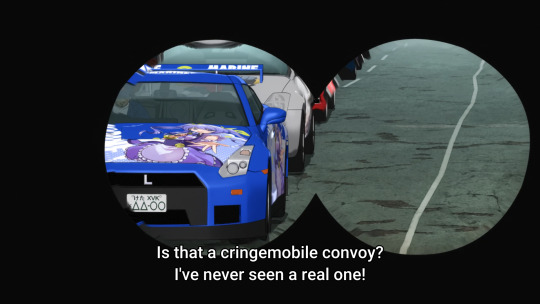
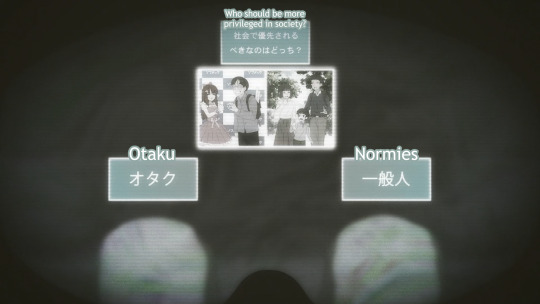

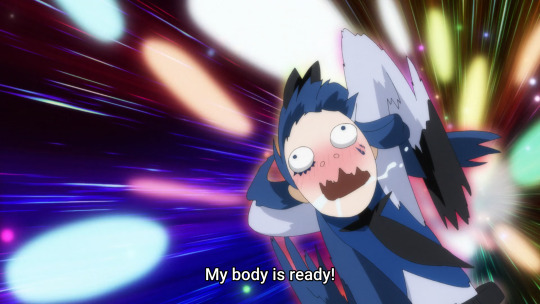
And for this particular show, subtitling with imageboard memes seems actually quite appropriate. But it's still so weird to see memesubs go official! It reads like a fansub!
As for the show itself... it's odd. I watched it pretty much entirely on the strength of the OP, which has both some lovely animation cuts including a little Weilin Zhang. Nobody figured out who did the car still. But where it really caught my attention is the glitched out second half that looks somewhere between SBAHJ and trans girl aesthetics. Here's a taste:


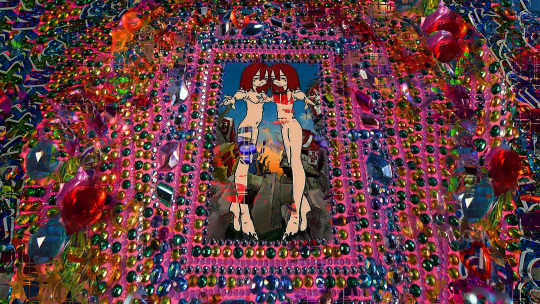
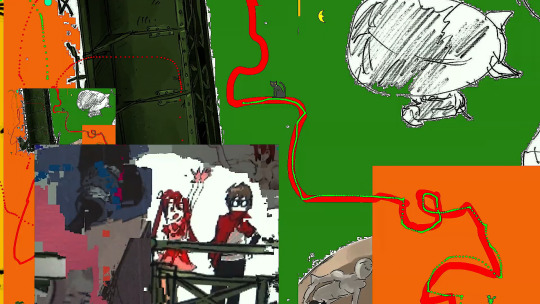
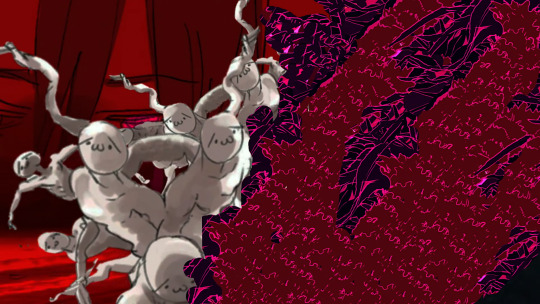
Based on that I expected something in the vein of Madoka, playing around with the form. Well, it's not that! Still trying to put my finger on what exactly it is.
I think I broadly I get what it's going for, sending up genre tropes and invoking various flavours of otaku subculture stuff with a really modern reference pool. And I appreciate that it's willing to go weird with it; episode 2 for example has a surreal battle on a drug induced psychic plane and they are willing to get quite experimental with the imagery (also obligatory EoE nod)...



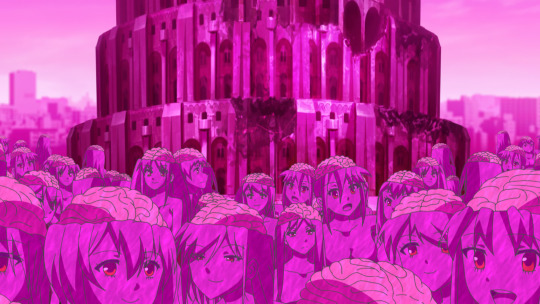
The henshin sequences likewise go pretty hard! Blue, the sex/masochism themed one in particular, gets her brain corkscrewed out and turned into a weapon. Lots of blink-and-you-miss-it stuff in all three.



There's other cute visual ideas riffing on the otaku theme; e.g. in episode 3, a mech is assembled like a model kit from a sprue by giant hands.
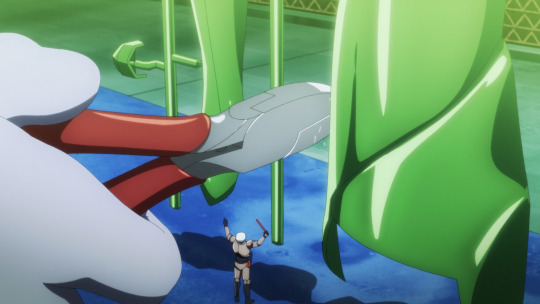
Or places where it's like... oh huh you went there then? It really foregrounds sexuality, playing it mostly for jokes but also like...
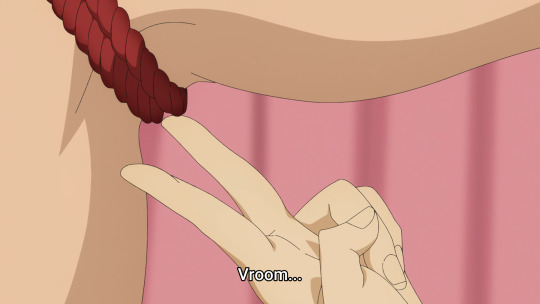
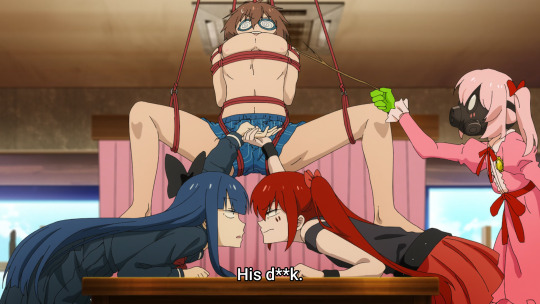
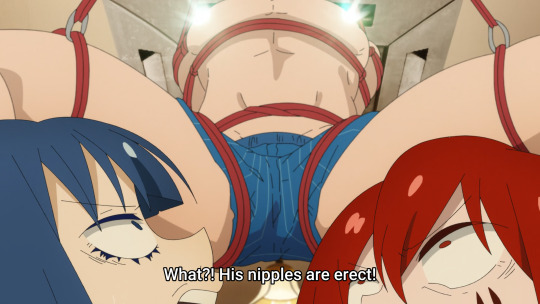
This isn't even the first time one of the characters has ended up in shibari and he stays that way for the rest of the episode.
Anyway, the story turned out to be about an alternate future where otakus become an oppressed class who are caged by the government; protagonist 'otaku hero' leads an otaku revolution, although he's more of a comic relief guy beside the three magical girls. The sort of mocking but affectionate sendup of otaku stuff feels sort of like 'what if you made Otaku no Video, 30 years on'.
So I respect its ambition! It certainly feels different.
Alas I don't think it quite comes together. The pace is pretty breakneck, but it's not so infectiously energetic as something like Kill La Kill, which is an obvious point of comparison - but then not many people can match Imaishi! Visually, the show proper is kinda rough, and inevitably falls short of the level set by its OP/ED. The story is way too overtly ironic to get seriously invested in, so you're mostly there for the jokes, which are pretty hit and miss (a lot of them are just 'haha, sex' or 'look, otaku thing'), but also it's paced so fast that they don't all have to stick.
It's a bit of a headscratcher honestly. I'm mostly still watching out of curiosity to see what they're doing with all this. It feels like there's several seeds of something in this mix; whether it will grow I can't tell.
Come to think of it, if it reminds me of anything, it's OtakuVs, the surprisingly high-effort anime comedy web series by some American weebs. The pace, tone, and sense of humour are remarkably similar. I'm probably missing some kind of precursor to both that explains it. Maybe it was poptepipic all along!
46 notes
·
View notes
Photo
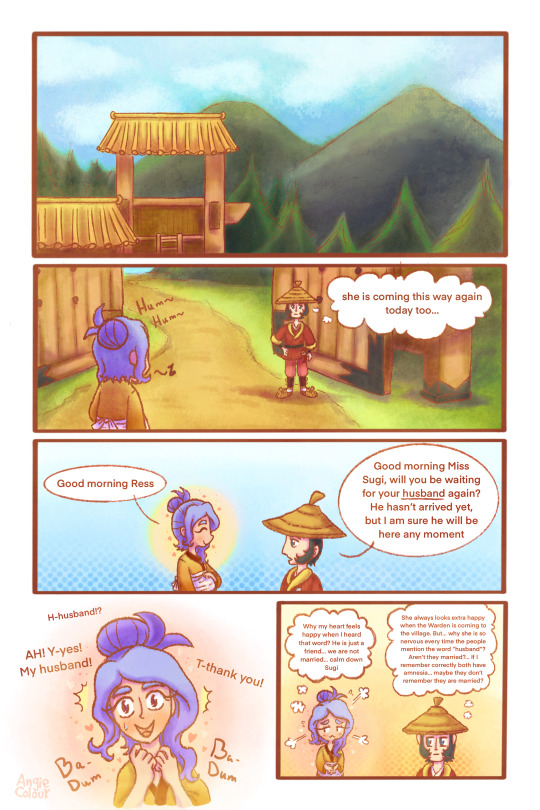


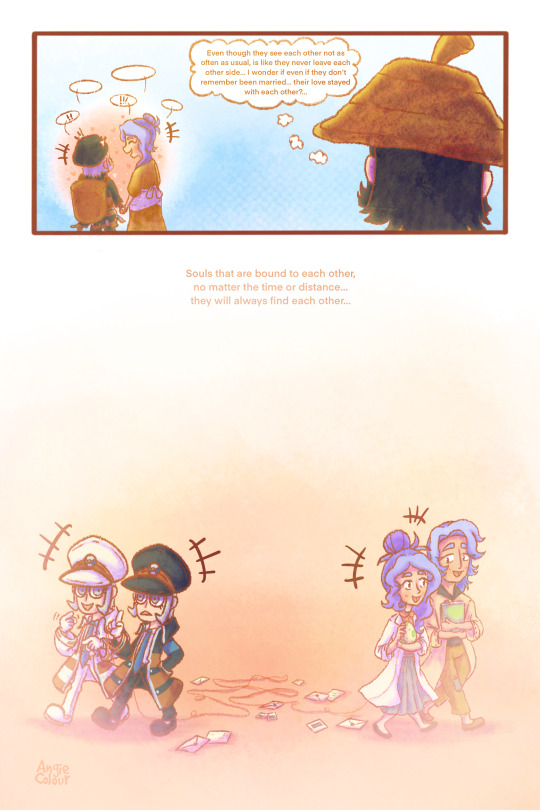
Soulbond
Sometimes souls that are bound to each other... no matter the time or the distance they face, they will always find each other
A follow up of the comics I have made so far! I was listening to this song in particular while doing this one in case someone want to read it with it!
This time I tried to make it very "Shōjo manga” on how Sugi perceives Ingo, sometimes she is just very happy to see him! (he gets happy to see her too, not everyday you find an amnesiac outsider like you in old Sinnoh)
I also wanted to add the idea of “red string of fate” since they do know each other before and do have feeling... is just they don’t remember
For some context, people at Jubilife and some of the Pearl Clan think both of them are married (they are not), but due to their “amnesia” they don’t remember it, so in a way “all mighty Sinnoh” was kind to them to reunited "the lovers” back again. In a way Sugi and Ingo just go with the idea (even tho they know is not true that they are married) since both have this feeling they once meet each other before but they can't quite understand “why”
Btw look!! Past Emmet and Sugi’s brother Kaede show up!! haha
Here is an order doing in case you want to read the ones before this one! as time pass I am sure I will add prologues for some stuff here and there but lets just make it this way for now!
First << Prev < Part 3 > Next
#pokemon#pokemon art#pokemon legends arceus#PLA#warden ingo#subway boss ingo#subway boss nobori#pokemon Arceus Ress#pokemon trainer oc#pokemon trainer sugi#papa ingo au#found family au#trainer oc#submas#subway boss emmet#pokemon trainer kaede#Penpastshipping || Ingo x Sugi#oc x canon#oc x character#ingo x oc
59 notes
·
View notes
Text
Fallece la renombrada creadora de manga Nanaeko Sasaya a los 74 años
El mundo del manga está de luto tras el fallecimiento de Nanaeko Sasaya el pasado 8 de junio a causa de un carcinoma de pulmón de células pequeñas. La destacada autora, parte del influyente Grupo del 24 de creadoras de manga, dejó un legado significativo en el género shōjo. Sasaya, quien debutó en 1970 bajo el nombre de Nanae Sasaya en la revista Ribon Comic de Shueisha con su obra…

View On WordPress
3 notes
·
View notes
Text
WIP Tag Game
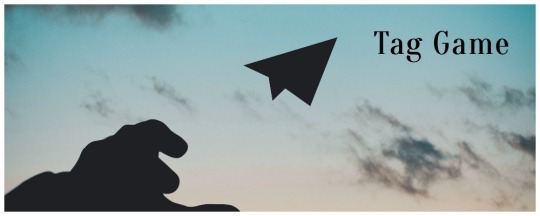
Thanks @kalira for the tag!
Rules
In a new post of your own, reveal the titles of the documents in your WIP folder and tag as many people as there are documents. Let others ask questions about the ones that interest them and post snippets or explain the contents as you see fit!
As will surprise no one whose talked to me for more than a minute, the list of my WIPs is insanely long, so I'm putting it under a cut!
Also, I will not be tagging as many people as I have WIPs - that's just Too Many People - but no-pressure tags for @dark-elf-writes, @maphel-n-doodles, @fiyasgideon, @tarutaruga, @devotedanarchy, @writhingbeneathyou, @artbythedarkside, @momo-ceros, @shinigami-mine, @woofgang69, @heyitswrenn, @longliveustherecklessandthebrave, @hellotheremaryrose, @silverutahraptor, @good-grievance
And please do ask about anything that sparks interest, though - I always love to talk about my WIPs!
I organise my WIPs by my series and then all other stories by pairing, so that's how they're listed here.
Courting Culture Confusion
Konohans Crash - the shinobi space race
Akatsuki Adventures - the last story in the series (I hope)
Other Naruto Stories
Madara/Tobirama
Untitled Single mother Tobirama - based on an idea by Madlen_Fade and borrowed with permission, four different versions plotted, running the gamut from angst to crack romantic comedy, and every one with a different pairing!!!
Tobirama/Izuna
Untitled Seelie Winter vs Summer Court story - Izuna is the King of Summer in love with the General of the Winter Court - Tobirama
Untitled djinn story - Izuna is a djinn, Tobirama is the king’s son who owns the bottle
Untitled Izuna is a pipe fox story - Tobirama is his sorcerer
Death is Not the End - Tobirama and Izuna novel, first part on AO3, is complete until I add everything else…
Untitled Tobirama is the Prettiest Princess - Tobirama/Izuna Modern AU with fashion porn and shy transwoman Kurohime
Untitled Tobirama/Izuna enemies to lovers amnesiac speedrun - amnesiac!Tobirama
Untitled Tobirama/Izuna enemies to lovers amnesiac speedrun - amnesiac!Izuna
Untitled Pacific Rim fusion - Pilot!Izuna/Engineer!Tobirama
Hold Your Children Precious - In a world where the Senju and Uchiha don't hunt children, the Uchiha win. Tobirama learns what it means to be married for peace.
A Confusion of Weasels - Izuna’s summons are weasels. Omegaverse.
A World Without You - fusion with the Matrix
Untitled Swan Lake AU, based on Odile and Odette
Untitled Mahō Shōjo Founders AU - complete and utter CRACK
Hashirama/Madara
Untitled Madara is a Disney princess - 500 Kingdoms fusion
Untitled Hashirama is a Disney Princess - Based on Enchanted
Untitled Romeo and Juliet quote parody - utter crack
Untitled Romeo and Juliet cannon era crack style romantic comedy
Untitled Romeo and Juliet modern AU - Hashirama and Madara are actors playing Romeo and Juliet
Rite of Passage - In which the only way to become a ‘true Senju’ is to eat Uchiha. Not dark, crack comedy
Untitled Edo Tensi Fourth War - Hashirama accepts Madara’s invitation to dance
Untitled extremely NSFW comedy in which Hashirama has an enormous dick and that's why he wears hakama whenever he's not in battle
Untitled Magic Coffee Shop AU
Founders Polycules
Untitled Girl Genius fusion - Necromancer Tobirama, Mechanicsburg sparks Madara and Izuna (they’re Hetrodyne equivalents)
Untitled sequel to Snow White - Hashirama/Madara, Izuna/Tobirama, Hashirama/Madara/Izuna/Tobirama
Suffered from the Night - Gothic Horror in which the Uchiha are vampires and the Senju are monster hunters
Untitled Madara/Tobirama/Izuna not really unrequited love - three versions, all of which are based on this amazing comic by @kurakura0-0
Kisame/?
Untitled A/B/O Kisame & Samehada hit on an Omega - Long, Kisame/Mei romance
Untitled Itachi fucks his way through the Akatsuki modern AU - Kisame/Itachi romance, SUPER LONG, the Akatsuki are a D&D group, Naruto and Sasuke are their dungeon masters, it’s BANANAS
Untitled Kisame/Itachi story - Itachi is a geisha about to have his mizuage. Kisame is the shinobi who bought him.
Budgie Smugglers - Itachi/Kisame porn in the onsen
Bridge of Birds - a retelling of Orihime and Hikoboshi
Laugh and Live - a retelling of The Tsarevna who Would not Laugh
Untitled Samehada/Kisame/Itachi story about scenting
Untitled Comfort Sex Kisame - or Kisame fucks his way through the Akatsuki
Other Pairings
Things that Zetsu Gave (and Gained) - Zetsu redemption angst fest
Untitled Zabuza/Kisame/Mei home repair modern AU
Untitled Team Ro polycule - All of Team Ro is in love with Iruka, but they don’t know about each other. Their only guide on how to woo him is Icha Icha. Oh no.
Untitled Arabian Night AU - Sakura/Hinata, Naruto/Sasuke. Hinata is the queen in an arranged married to Naruto, but he doesn't love her. Her only solace is her handmaiden, Sakura.
Untitled Deidara/Sasori - Everyone thinks Deidara uses ‘danna’ sarcastically, and that’s just the way he likes it. Two versions, one happy and one sad
Untitled 1920s Mob Uchiha - Series based on the art of @good-grievance
Untitled Senju Breathplay - Two versions - Hashirama/Tobirama and Tobirama/Tōka
Untitled Kisame/Itachi/Haku/Zabuza College AU
War of the Dōjutsu (Now Fight!) - Hashirama/Hikaku
Untitled Tobirama/Hikaku story - they bond over paperwork
Untitled series - four unrelated stories, all of them based on the music video Dude (Looks Like A Lady) by Aerosmith. Each one featuring a different founder.
Gen
Untitled Izuna is the heir - Gen, long and utterly violent mix of angst and crack
Untitled Modern High School AU - Gen, probably about 20K, pretty wholesome story about growing up, now with a Hashirama/Madara cat cafe sequel, a Mito/Tōka/Naori Much Ado About Nothing sequel, and a Tobirama/Izuna sequel
The Feeling of Falling - Kakashi is a self-insert into Naruto, Kakashi-centric Naruto/Inception crossover
Untitled Tajima and Mountains - Tajima named his kids after mountains. This is why.
Minecraft Madness - Obito and Zabuza are on the same Minecraft Server. It doesn’t go well.
Untitled Akatsuki run a restaurant Modern AU
Untitled cannon era story in which the Hatake have nine lives - an unholy mix of angst and crack
The Past Is a Foreign Country (they do things differently there) - metatextual commentary on cannon, similar to In All the World
A Clowder of Cats - A series in which the Uchiha are all cats
Ladybug, Ladybug, Fly Away Home - a series of stories about Fū being brought up by the Akatsuki
Les Misérables
Rapunzel Enrolas
27 Dresses AU
Other
All the Tropes in Asian Drama story
And… I think that’s everything.
It’s more than I thought, but less than I was dreading.
That’s good.
I think.
6 notes
·
View notes
Text

A Sign of Affection
6 volumes (in English as of 4/19/2023. Digital-first, now being published in print, as well.)
Licensed by Kodansha, also available on INKR Comics
Yuki is a college student who’s into friends and fashion. She’s also deaf. A chance meeting on a train leads to a serious crush… but can it grow into something more? A sweet and touching manga romance from the creator of Shortcake Cake!
Yuki, who’s always been deaf, is used to communicating with sign language and her phone. But she’s not used to English, so when a tourist from overseas asks for directions, she nearly panics…until a handsome stranger steps in to help. His name is Itsuomi, and it turns out he’s a friend of a friend. A charismatic globetrotter, Itsuomi speaks three languages, but he’s never had a deaf friend. The two feel drawn to each other and plan a date on a romantic winter’s night…but Yuki’s friend is afraid that she might be setting herself up to get hurt. Could this be something real? Or will these feelings melt away with the snow?
From the acclaimed author of Shortcake Cake, the hit shojo series with more than a million copies in print, this new work is full of real-life details about Japanese sign language and living without hearing, and it’s sure to please fans of romantic stories like A Silent Voice, Kimi ni Todoke, and Love in Focus!
Note: Nominated for the first Ebook Japan manga award in 2020. Nominated for the Kodansha Manga Award in the Shōjo category in 2021, 2022 and 2023. Won the grand prize at the eleventh An An manga award in 2021. Nominated for the 68th Shogakukan Manga Award in the Shōjo category in 2022.
Status in Country of Origin
8 Volumes (Ongoing)
Tags:
Affectionate Couple
Assertive Female Lead
Award-Winning Work
Bar/s
College
Couple Growth
Cute Female Lead
Deaf Protagonist
Disability/ies
Female Lead Falls in Love First
First Love
Friendship
Germany
Height Difference
Language Barrier
Multiple Couples
Part-Time Job
Post-Secondary School
Post-Secondary Student/s
Tattoo/s
Travel
Unrequited Love
World Travel
#a sign of affection#manga#art#shoujo#dessert#kodansha#ongoing#Yubisaki to Renren#drama#romance#school life#slice of life#MORISHITA Suu#2019#2010s#inkr comics
8 notes
·
View notes
Note
Hello! I want to say I read Anomique and I loved it very much! I'm wondering if you could explain your train of thought for some of the symbolism? I found it all very interesting and they hit a whole lot harder the second time I read through
THANK YOU SO MUCH FOR THIS ASK AND READING MY LITTLE COMIC!! It means so much to me each person that gives it a chance!
Also spoilers ahead, so whoever is reading this post please consider checking the comic before seeing what's in here. Please and thank you!
I thought portraying the story in a world of magical girls was pretty fitting for what I wanted to discuss. I considered other genres, but when you really think about it, one of the main things about mahō shōjo stories is that these young people get to transform into more powerful, more "perfect" versions of themselves to fight off evil and prove themselves as strong and reliable figures to the world they're defending. While not all in the genre, most of these feature characters going magical in secret, almost as if that identity of theirs is separate from their day-to-day selves. Something interesting about this aspect of these stories is that either they personally really don't want to be found out while using magic out of fear, or cannot for other reasons but really wish they could reveal it... I could go on and on about the parallels here, but so much seems to coincide with the topics Anomique tries to depict. It also just feels right as some of these shows were and still are personal favorites of mine to this day which might be the case for lots of people like me! It all just made too much sense for me not to go with that.
I wanted to discuss and depict so, so much more but I purposely decided this should be a small project I could handle without much difficulty as this was my first time ever making an original comic of any sort, with no real prior experience of the sort. Hopefully what I still managed to put out has good value and gives people some food for thought as I think this sort of inner conflict in these kinds of small and vulnerable communities ignited by the interests and hostility of people outside of it isn't discussed nearly enough from what I've seen. My hope is that we can become kinder and more considerate people to one another as time goes on as we realize how silly focusing on such small differences that aren't actually so harmful really is.
Again, THANK YOU so very much for reading Anomique and also sending this ask, I hope to have shed some light on some of your curiosity! Have a nice and chill weekend!
1 note
·
View note
Text
whyre so many animes set in europe
García Aranda, Oscar. 2020. “Representations of Europe in Japanese Anime: An Overview of Case Studies and Theoretical Frameworks”. Mutual Images Journal, no. 8 (June):47-84. https://doi.org/10.32926/2020.8.ara.europ.
Aranda did a comparative analysis of three types of anime: 1970s Shōjo animes based on Japanese mangas, the “Meisaku” series which is animes based on European and American literature, and animes made since the 1980s. In his research, he concluded that there’s some evidence pointing to Europe being a way to show a culture that’s entirely different from Japan’s. Aranda also mentioned that setting an anime in Europe allowed creators the freedom to explore outside of Japanese taboos.
Hayao Miyazaki et al.. 2017. Castle in the Sky. Shout Factory.
Castle in the Sky is a film based on Wales. The plot follows a girl from a mythical sky race after cascading into the arms of a land boy. The two begin to embark on their journey back to Laputa, the titular castle in the sky. The film blends the themes of magic and technology, with the floating islands and Sheeta’s floating crystal tying her back to Laputa. Overall, this film definitely paints Wales to be a more mystical place than possible.
Hayao Miyazaki et al.. 2006. Howl's Moving Castle. Burbank, CA, Walt Disney Home Entertainment.
Shown with enchanting towns and a romantic feel, Howl’s Moving Castle shows France with a whimsical lens. There are two conflicting narratives, though, because the film also shows the darker part of French history.
Sutter, Rebecca. “Orientalism, Self-Orientalism, and Occidentalism in the Visual-Verbal Medium of Japanese Girls’ Comics.” CORE 22 (2), 2014: 18. https://openjournals.library.sydney.edu.au/LA/article/view/7618.
In this journal, Sutter describes the fantastical way Japanese anime portrays European life and culture as a reverse orientalism. Especially in Shōjo anime, Europe is shown to be exotic and foreign, kind of like how the Western world sees the East.
The Soak. “Anime’s Obsession With Europe: A Brief History.” YouTube, 2024. March 31. https://www.youtube.com/watch?v=jXjfzMCbaBc.
This video delves into the history of Japan to understand the titular question. The creator goes over the sakoku period, 200 years when Japan was almost completely isolated from the world. He continues by talking about the Meiji period, the time immediately following isolation when Japan was getting an influx of content from Europe. He explains that anime, specifically Shōjo anime, was effected by the flood of culture from Europe. The ideas of homoerotic friendships and androgyny were depicted and continued into the anime we have presently. Overall, the creator blamed Japan’s isolation and the freedom from taboos for the amount of animes set in Europe
0 notes
Text
Exploring the World of Manga and Anime

Manga and anime have become integral parts of global pop culture, captivating millions with their unique storytelling, diverse genres, and distinctive art styles. Originating from Japan, manga refers to comic books or graphic novels, while anime encompasses animated television shows and films. Together, they form a vibrant medium that appeals to a broad audience, from children to adults.
The Roots of Manga
The history of manga dates back centuries, with early examples found in Japanese woodblock prints and illustrated narratives. However, the modern form of manga began to take shape in the late 19th century, influenced by Western comics. The post-World War II era marked a significant turning point, as artists like Osamu Tezuka, often called the "God of Manga," pioneered new storytelling techniques and character designs. His work laid the groundwork for many manga genres that followed, such as shōnen (targeted at young boys), shōjo (for young girls), and seinen (aimed at adult men).
The Growth of Anime
Anime, which emerged in the early 20th century, initially drew from the same artistic traditions as manga. The first Japanese animated films were heavily influenced by Western animations. However, it was not until the 1960s that anime began to gain a distinct identity, with series like "Astro Boy" gaining popularity. The 1980s and 1990s saw a boom in the anime industry, with titles like "Dragon Ball," "Sailor Moon," and "Neon Genesis Evangelion" becoming cultural phenomena.
Genres and Themes
Both manga and anime are characterized by their rich variety of genres and themes. Common genres include action, adventure, romance, horror, fantasy, and science fiction. Moreover, sub-genres such as isekai (transported to another world) and slice of life (depicting everyday life) have gained popularity in recent years.
One of the reasons for the widespread appeal of manga and anime is their ability to tackle complex themes and societal issues. Many series explore topics such as friendship, love, sacrifice, identity, and mental health, resonating deeply with audiences. For instance, "Your Lie in April" delves into themes of grief and the healing power of music, while "Attack on Titan" examines freedom and oppression.
The Global Impact
Manga and anime have transcended cultural boundaries, gaining immense popularity outside Japan. The rise of streaming platforms like Crunchyroll and Netflix has made it easier for international audiences to access a wide array of titles, from classic series to the latest hits. This globalization has led to a burgeoning fanbase, with conventions, merchandise, and online communities dedicated to discussing and celebrating these art forms.
Moreover, the influence of manga and anime can be seen in various aspects of Western entertainment. Many Hollywood films and series have drawn inspiration from Japanese storytelling techniques, visual aesthetics, and character development. The success of adaptations, such as "Avatar: The Last Airbender," showcases how these narratives can resonate with diverse audiences.
The Future of Manga and Anime
As technology continues to evolve, so does the world of manga and anime. Digital platforms are changing the way creators produce and distribute their work, allowing for greater experimentation and accessibility. The rise of webtoons and digital manga has introduced new formats, catering to younger audiences who consume content on their devices.
In conclusion, manga and anime represent a dynamic and evolving cultural phenomenon that continues to captivate audiences worldwide. Their rich storytelling, complex characters, and diverse genres offer something for everyone, ensuring their place in the hearts of fans for generations to come. As both mediums continue to innovate and adapt, they will undoubtedly shape the future of entertainment and storytelling.
#Manga and Anime#Manga and anime characters#Manga and anime difference#Japanese anime and manga#Manga and anime series#Best manga and anime#Manga and anime list
0 notes
Text
The New Rose of Versailles Anime: At What Cost?
Clips of the new Rose of Versailles anime made by MAPPA are beautiful, but it leaves a rancid taste when the very same company is known for working their staff like machines (read: AOT staff) and destroying the livelihood of women in the industry.
Yes, I refer to their prime example of fumbling Yuri on Ice until it may never see the light of day again. Their first ‘big’ production headed by Yamamoto Sayo which put them on the map for further opportunities.
After that, we see some more queer anime from MAPPA after their great success: Banana Fish and Zombieland Saga.
They even go one step further to make a sub studio Grizzly, which released Yarichin Bitch Club. It was headed under the Yuri on Ice producer, Fuko Noda, who eventually left (probably due to how awful the YOI situation was).
Wait, why am I mentioning this?
It’s important to note that in Japan, BL is considered under the female demographic. This is because BL breaks the social norms and explores topics less discussed.
https://savvytokyo.com/boys-love-the-genre-that-liberates-japanese-women-to-create-a-world-of-their-own/
This is also how the modern shoujo works became what it was today. In the 1950s, shoujo was a genre created mostly by men. Most stories were of tragic and passive heroines who bravely endured hardships.
Mangaka would publish shoujo in training for shounen manga. The genre was rarely mentioned in articles and considered sub-par to shounen.
Gradually, this began to change in the 60s but shoujo really ushered in a golden age in the 70s, spearheaded by the Magnificent 49ers group. (Showa 24)
Magnificent 49ers or refers to a group of female mangaka born around 1949, in the 24th year of Showa. They wrested control away from men through popular and appealing works that define shoujo today.
Amongst them are Hagio Moto, considered the founding mother of shoujo, Oshima Yumiko, Takemiya Keiko and Ikeda Riyoko, the mangaka of Rose of Versailles.
Now we’ve reached the meat of the plot, with such a history it does a great disservice to have an inhumane company like MAPPA which disregards women and the demographic to represent Rose of Versailles.
The manga itself is about characters which defy social norms and questions their expected identities. How can a studio, which axed all its queer shows and silenced their staff with NDAs be a good fit for a story which contradicts MAPPA?
After disappointing and clowning their female fan base since 2016, MAPPA is now trying to pander to the shoujo fandom again.
They see us as disposable commodities, cash cows to throw away when it gets hard. Please don’t let them, don’t support MAPPA in any way and pirate if you really want to watch it.

#shojo#shoujo#rose of versailles#riyoko ikeda#year 24 group#mappa#history#literature#yuri on ice#anime#manga
127 notes
·
View notes
Note
As the market and critical/academic interest for graphic novels has exploded over the past decade or so, what are some of the prevailing trends (narrative, thematic, aesthetic, formal) in the medium that you like or don’t like? This seems like something you may have already addressed in a few places, so forgive me if you have.
I'll start with the positive: the internationalization of the field and the greater sense of archival or curatorial responsibility some editors and publishers have, extending even now even to a Norton Critical Edition of Will Eisner. I'm ambivalent about the overwhelming tide of manga, but at least it sustains the publication of the classic and less commercial manga, whether Tezuka's work or the Japanese underground scene or the early shōjo and josei, just as major works in the Franco-Belgian and Latin American traditions have also been published, sometimes for the first time and sometimes for the first time in complete and durable editions. (I've discussed a lot of this material on my website; just scroll down to "Comics" in the Review Index.)
More negatively, we've seen the re-infantilization of so much of the mainstream industry with the rise of YA. I've explained it as an effect of the change in distribution: comics went from the young and slightly male-skewed newsstand market (1930s-1960s) to the adolescent and adult but definitely male-skewed direct market (1970s-2010s) to the young and definitely female-skewed digital, bookstore, and library markets. Even John Constantine has not been spared YAification. The influence of YA and of manga together discourage any type of intricacy either in illustration or language. The types of new mainstream comics published in the 1980s and '90s are scarce today, especially considering their intense allusiveness, their double investments both in counterculture (not today's NGO astroturfed counterculture, though there are continuities of subject matter) and in the high literary and artistic traditions. I can't shake the feeling that it was better to read Arkham Asylum outside the curriculum at a very young age than to read Gender Queer at the same age within the curriculum. But all the real action, I'm sure, is online and quasi-invisible to any kind of mainstream, as it should be.
0 notes